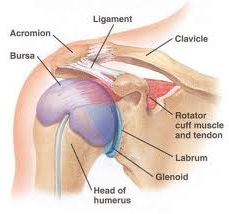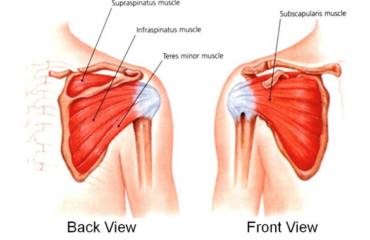Of the various physical ailments a person can develop, pain in the shoulder is one of the most common. The shoulder is a combination of multiple muscles and tendons that help sustain the joint, providing a large range of motion for the ball and joint socket that houses the arm.
Since there are such a large number of components for this joint, the number of pain causing complications that can be present is higher. Commonly seen sources of pain in the shoulder can be any number of conditions regarding the rotator cuff.
Components of the Shoulder
The shoulder is the meeting place of three major bones in the body: The shoulder blade (scapula), the collarbone (clavicle), and the bone of the upper arm (the humerus). The bone of the arm ends in a ball-like cap that is housed within the socket formed by the shoulder blade and collar bone. The arm is held into this area by the rotator cuff and a cluster of muscles and tendons. These form a muscular cover over the arm and attach it to the surrounding socket.
Located between the rotator cuff and the bone of the shoulder is a sac of fluid referred to as a bursa. The bursa serves to keep movement of the rotator cuff easy by actively lubricating the joint, allowing it to move freely as the arm is taken through its range of motion.
Complications with the Rotator Cuff
Since the rotator cuff plays such a large role in the movement of the arm, it can be easy to see  why it is such a common source of pain. Nearly any complication of the cuff will cause pain for the patient and impede the function of the arm to some degree.
why it is such a common source of pain. Nearly any complication of the cuff will cause pain for the patient and impede the function of the arm to some degree.
The common complications seen among patients include rotator cuff tendinitis, where the tendons of the cuff are damaged or irritated. Common causes for this include inflammation of the area and a ripping or tearing of the tendons as the result of injury.
Rotator cuff bursitis is an inflammation of the bursa sac that lubricates the cuff, resulting in the swelling of the bursa sac with excess fluid. This swelling can impede movement of the arm as well as cause pain if the rotator cuff exerts pressure on the inflamed sac.
Rotator cuff impingement occurs when the arm is raised to shoulder height and part of the socket rubs strongly against the tendons and bursa sac. This is also known as shoulder impingement.
Common Causes of Rotator Cuff Pain
Almost any activity that has a person using their arm frequently may potentially result in some degree of damage to the rotator cuff. It is common to see this condition in both young and  middle-aged athletes as well as those who raise their arms overhead frequently through work or a hobby such as bowling, swimming, kayaking, or pitching and throwing sports.
middle-aged athletes as well as those who raise their arms overhead frequently through work or a hobby such as bowling, swimming, kayaking, or pitching and throwing sports.


